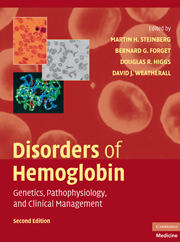Book contents
- Frontmatter
- Contents
- List of Contributors
- Foreword, by H. Franklin Bunn
- Preface
- Introduction, by David J. Weatherall
- SECTION ONE THE MOLECULAR, CELLULAR, AND GENETIC BASIS OF HEMOGLOBIN DISORDERS
- SECTION TWO PATHOPHYSIOLOGY OF HEMOGLOBIN AND ITS DISORDERS
- SECTION THREE α THALASSEMIA
- SECTION FOUR THE β THALASSEMIAS
- SECTION FIVE SICKLE CELL DISEASE
- 19 Clinical and Pathophysiological Aspects of Sickle Cell Anemia
- 20 Sickle Cell Pain: Biology, Etiology, and Treatment
- 21 Hemoglobin SC Disease and Hemoglobin C Disorders
- 22 Sickle Cell Trait
- 23 Other Sickle Hemoglobinopathies
- SECTION SIX OTHER CLINICALLY IMPORTANT DISORDERS OF HEMOGLOBIN
- SECTION SEVEN SPECIAL TOPICS IN HEMOGLOBINOPATHIES
- SECTION EIGHT NEW APPROACHES TO THE TREATMENT OF HEMOGLOBINOPATHIES AND THALASSEMIA
- Index
- Plate section
- References
20 - Sickle Cell Pain: Biology, Etiology, and Treatment
from SECTION FIVE - SICKLE CELL DISEASE
Published online by Cambridge University Press: 03 May 2010
- Frontmatter
- Contents
- List of Contributors
- Foreword, by H. Franklin Bunn
- Preface
- Introduction, by David J. Weatherall
- SECTION ONE THE MOLECULAR, CELLULAR, AND GENETIC BASIS OF HEMOGLOBIN DISORDERS
- SECTION TWO PATHOPHYSIOLOGY OF HEMOGLOBIN AND ITS DISORDERS
- SECTION THREE α THALASSEMIA
- SECTION FOUR THE β THALASSEMIAS
- SECTION FIVE SICKLE CELL DISEASE
- 19 Clinical and Pathophysiological Aspects of Sickle Cell Anemia
- 20 Sickle Cell Pain: Biology, Etiology, and Treatment
- 21 Hemoglobin SC Disease and Hemoglobin C Disorders
- 22 Sickle Cell Trait
- 23 Other Sickle Hemoglobinopathies
- SECTION SIX OTHER CLINICALLY IMPORTANT DISORDERS OF HEMOGLOBIN
- SECTION SEVEN SPECIAL TOPICS IN HEMOGLOBINOPATHIES
- SECTION EIGHT NEW APPROACHES TO THE TREATMENT OF HEMOGLOBINOPATHIES AND THALASSEMIA
- Index
- Plate section
- References
Summary
INTRODUCTION
Definition of Acute Pain Episodes
Pain is an unpleasant sensory and emotional experience. Acute pain episodes in sickle cell disease are mildly to excruciatingly unpleasant sensory and emotional experiences that occur episodically and unpredictably in one or many parts of the body, lasting from hours to weeks for which there is no other pathological explanation. Episodes of acute pain are the most common and distressing manifestations of sickle cell disease for the affected individual and their families. Their onset is early in life and unpredictable recurrences cause life-long suffering; they are disruptive to social and psychological functioning; they result in frequent utilization of healthcare resources, and they are a predictor of reduced survival.
Pain can occur anywhere, be localized to one or a few areas, be migratory, or be generalized. Back, chest, extremities, and joints are most often involved. Swelling and tenderness over affected areas and low-grade fever are common. The pain episode occurs in phases with an average length of approximately 10 days in adults.
The pathophysiology of painful episodes is poorly understood despite years of investigation. Observations during acute painful events suggest they result from diffuse ischemia of bones and muscles caused by disruption of blood flow in small and large blood vessels. The pathogenesis of the disruption of blood flow is complex and not well understood and is likely to be related to sickle cell–related vasoocclusion and vasculopathy, whose proximate cause is polymerization of deoxygenated sickle hemoglobin (HbS).
- Type
- Chapter
- Information
- Disorders of HemoglobinGenetics, Pathophysiology, and Clinical Management, pp. 497 - 524Publisher: Cambridge University PressPrint publication year: 2009
References
- 5
- Cited by



